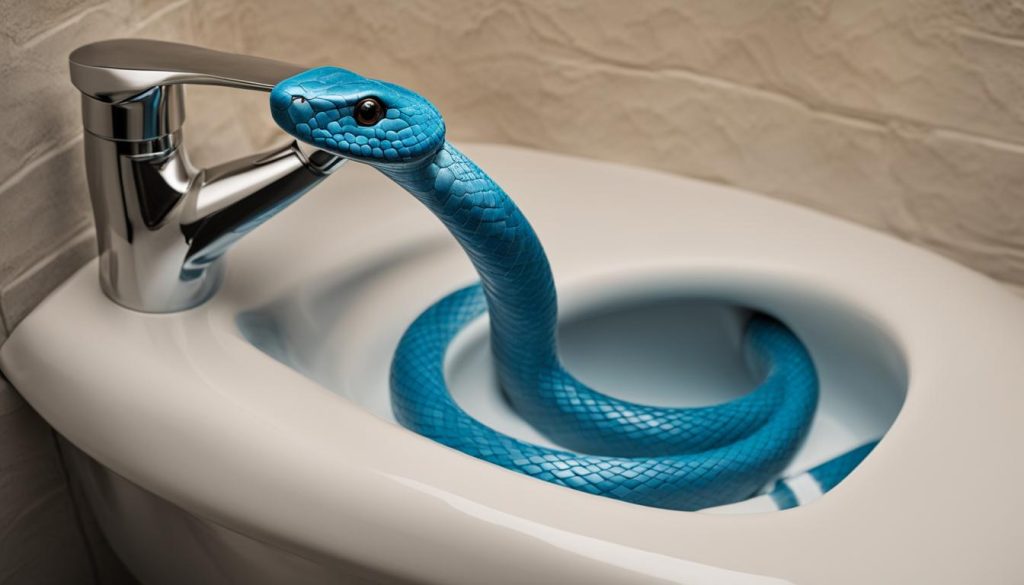Unlock Clogs: How Does a Drain Snake Work?
Did you know that clogs in drains cost Canadians millions of dollars in plumbing repairs each year? Whether it’s a pesky hairball or a buildup of soap scum, clogged drains can be a frustrating and inconvenient problem to deal with. But fear not! There’s a handy tool that can solve this issue and save you time and money: the drain snake, also known as a drain auger or plumbing snake.
So, how does a drain snake work its magic? Let me break it down for you. A drain snake consists of a long, flexible metal cable coiled inside a drum. By manually turning the handle on the drum, the cable is pushed into the drain to break up and remove clogs. The end of the cable is equipped with a corkscrew-shaped spring that grabs onto the obstruction, allowing it to be pulled back out.
Drain snakes are especially effective for clearing soft clogs caused by hair, soap scum, and other debris. They can reach clogs located up to 15 to 25 feet down the drain line. However, it’s important to note that drain snakes are not designed to pick up heavy items or cut through obstructions in drainage pipes.
Using a drain snake is a cost-effective and convenient way to unclog your drains without having to call a plumber for routine clogs. So why not give it a try and become your own handyman?
Key Takeaways:
- A drain snake is a versatile tool used to clear clogs in sinks, showers, tubs, and other drains.
- It consists of a long, flexible metal cable coiled inside a drum.
- By manually turning the handle, the cable is pushed into the drain to break up and remove clogs.
- Drain snakes are effective for clearing soft clogs caused by hair, soap scum, and other debris.
- They can reach clogs located up to 15 to 25 feet down the drain line.
How to Use a Drain Snake
Using a drain snake, also known as a drain auger, is a straightforward process that can help you clear pesky clogs in your drains. Here is a step-by-step guide on how to use this essential plumber tool to clear clogs and keep your drains flowing smoothly:
- Begin by loosening the thumbscrew on the drum of the drain snake. This will allow you to extend the cable by hand.
- Insert the corkscrew end of the drain snake into the drain pipe until you feel resistance from the clog.
- Tighten the thumbscrew to secure the cable in place.
- With a firm grip on the drain snake, slowly rotate the handle two or three times. This rotational motion will help break up the clog and allow the snake to grab onto it.
- Loosen the thumbscrew again and start pulling the cable back towards you. As you retract the drain snake, it will bring along the loosened debris from the clog.
- If necessary, repeat the process by reinserting the drain snake and breaking up the remaining clog until the drain is clear.
Once you have successfully cleared the clog with the drain snake, remember to reassemble the drainage pipe properly. Run water to ensure the drain is functioning correctly after using the drain snake. It is also crucial to wash and dry the drain snake thoroughly after use to prevent rust and bacterial contamination.
Types of Drain Snakes
When it comes to tackling stubborn drain clogs, having the right tool for the job can make all the difference. There are several types of drain snakes available, each designed to handle specific types of clogs and drain sizes. Let’s take a closer look at some of the most commonly used drain snakes:
1. Power Augers
Power augers are a popular choice for professional plumbers and homeowners alike. These drain snakes are equipped with a motor that provides additional power, making them ideal for pushing the cable through tight clogs. Power augers are especially effective for clearing larger and more stubborn obstructions.
2. Cable Drain Augers
Cable drain augers, also known as manual drain snakes, are the go-to tool for reaching clogs deep within drain pipes. These versatile drain snakes feature a corkscrew end on the cable head, allowing them to grip onto the obstruction and break it up. Cable drain augers are available in different lengths to accommodate various drain lengths.
3. Flat Tape Augers
Flat tape augers are specifically designed for smaller pipes with a diameter of 2 inches or less. The unique flat cable with an auger tip allows these drain snakes to navigate through narrow pipes with ease. They are great for removing soft clogs caused by hair, soap scum, and other debris in bathroom sinks and tubs.
4. Toilet Augers
When it comes to clearing clogs in toilets, a specialized tool called a toilet auger is the best option. Toilet augers are designed to navigate through the curved trap of the toilet without causing any damage. These drain snakes have flexible cables that can reach deep into the toilet’s drainage system to break up and remove the obstruction.
Choosing the right drain snake for the job is essential for effective clog removal. Consider the type of clog and the size of the drain before selecting the appropriate drain snake. Using the wrong type of drain snake may not only be ineffective but can also damage the pipes.
| Drain Snake | Best For |
|---|---|
| Power Auger | Tight and stubborn clogs |
| Cable Drain Auger | Deep clogs in larger drain pipes |
| Flat Tape Auger | Small pipes with a diameter of 2 inches or less |
| Toilet Auger | Clogs in toilets |
Investing in a high-quality drain snake that suits your specific needs can save you time and money in the long run. Remember to always follow the manufacturer’s instructions and take proper safety precautions when using a drain snake.
With the right drain snake in hand, you can confidently tackle clogs and keep your drains flowing smoothly.
When to Call a Professional Plumber
While drain snakes are effective for clearing most soft clogs, there are instances when it is necessary to call a professional plumber. If the clog persists or is located beyond the reach of your drain snake, it is advisable to seek professional assistance. Plumbers have specialized equipment, such as motorized sewer machines, that can handle more stubborn clogs and even dislodge solid items stuck in pipes, like tree roots. Additionally, if the clog is causing an uncontrollable mess or affecting multiple drains in your home, it is best to leave it to the experts. Professional drain cleaning services are relatively affordable and can provide a practical solution to complex clogs.
Here are some situations when it’s time to pick up the phone and call a professional:
- When the clog persists after multiple attempts using a drain snake.
- When the clog is located deep within the drain pipe, beyond the reach of a DIY tool.
- When the clog is caused by stubborn materials, like tree roots or solid objects.
- When the clog is causing water backups or sewage leaks.
- When the clog affects multiple drains in your home.
| When to Call a Professional Plumber | Detailed Reasons |
|---|---|
| The clog persists after multiple attempts using a drain snake. | The professional plumber has specialized equipment to handle stubborn clogs. |
| The clog is located deep within the drain pipe, beyond the reach of a DIY tool. | The professional plumber can access the clog with motorized sewer machines. |
| The clog is caused by stubborn materials, like tree roots or solid objects. | The professional plumber has the expertise to dislodge tree roots and remove solid objects from pipes. |
| The clog is causing water backups or sewage leaks. | The professional plumber can address the issue and prevent further damage. |
| The clog affects multiple drains in your home. | The professional plumber can identify and resolve the underlying issue causing the widespread clogs. |
Preventing Drain Clogs
Taking preventive measures is essential to avoid troublesome drain clogs. One effective method is installing a sink strainer in your drain, which acts as a barrier to prevent debris and small objects from entering the drainpipe. By catching these potential clog-causing culprits, the sink strainer ensures smoother water flow and fewer blockages.
Proper usage of a garbage disposal is another key aspect of preventing drain clogs. When using the garbage disposal, remember to run cold water at full volume while the machine is in use. After turning it off, let the water run for an additional minute. This simple step ensures that the garbage is fully flushed down the drain and into the larger main drainpipe, reducing the chances of clogs forming.
It is important to avoid dumping materials like plaster or wallboard compound down the drain, as these substances can harden and lead to stubborn clogs. Instead, dispose of these materials properly in the designated waste containers. By implementing these straightforward practices, you can effectively minimize the risk of drain clogs and maintain proper drainage in your home.
- Investing Wisely: How Windows & Doors in Boost Property Value and Financial Health - April 24, 2025
- The Financial Impact of Personal Injuries: Why Legal Help Matters for Business Owners - April 16, 2025
- The Hidden Financial Costs of Domestic Assault: What Business Owners Need to Know - April 16, 2025














